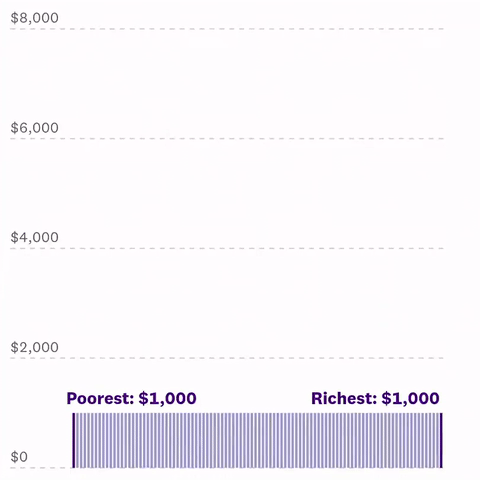My last newsletter was about how we are pretty good at talking about people having money, and we’re pretty good at talking about a nation being unequal.
We have plenty to say about high prices or seemingly-unfair earnings.
And we have even more to say about poverty and inequality.
However, we’re not so good at understanding how you get from that starting point, of someone having a bit more money, to the place we are here—where we have serious inequality.
That might sound like a contradiction. After all, it seems obvious that if one person has money, other people don’t! But you’re forgetting that money is neither especially limited in supply, or especially limited in where it goes.
We accept it now as some kind of ‘universal truth’, but the idea that money should ever-increasingly-concentrate in one place is actually silly when you step back to consider it.
It’s like assuming a bucket of ball-bearings, tipped onto a flat surface, will eventually all naturally coalesce into the shape of a mouse.
Money is supposed to be neutral, so it should operate the same way for all of us. And yet, even when we apply carefully-considered, logical, common-sense to that end, it just doesn’t operate the way we expect it to.
So, Part 1 was about considering how one way wealth goes from start to here is via shared misunderstanding.
But, I’m guessing there was another thing you thought when I started talking about money magically ‘tipping the scales’ like that: You thought I was going to talk about corruption and political lobbying and donations.
Even though those are definitely a factor, I want you to start this newsletter by removing those ideas from your head.
I want you to reset the picture you have in your mind of ‘an ultra-rich person’. I want you to strip it right back, until all you’re left with is a perfectly ethical and honest operator who intends you no harm or exploitation.
This is really important, to help us understand why inequality exists…
Most of the magic that wealth ‘plays us’ with involves some kind of trickery or con:
The optimism that makes us believe we all benefit from inequality
The misdirection that causes us to forget wealthy people are just people
And now we understand how common-sense can be used against us, to blind us to an obvious truth.
However, wealth isn’t all about magic. Sometimes it’s just about momentum.
Which brings me to the second, and more important way that money tips the scales on the way to inequality.
Honestly, this one is explained in more detail, and with better pictures, over at The Pudding so I won’t be offended if you just click the Like button to thank me for the recommendation, then head over there! But, I’d also love for you to stick around for my summarised version, which goes a bit like this…
We assume that, on balance, our trading is largely “fair”. Sometimes we score a bargain, sometimes we pay too much, but mostly it ‘all comes out in the wash’.
But that’s not actually true. Because there is an inbuilt, and invisible, advantage built into having money.
Remember, we’re not talking about lucky lottery wins. We’re not talking about an ability to lobby governments or pay accountants, or even to buy specific assets. Remember, our rich people are ethical, honest and intend no harm1.
What I’m talking about here is simple momentum.
Imagine a coin flip. You’ve got a 50:50 chance of winning right? Heads, or Tails.
Let’s make it interesting. I’m heads; you’re tails. We start with $100 each, and bet 10% of the lowest balance on each toss
First toss – for 10% of $100 ($10): HEADS, I win!
Balance: $110 (me) / $90 (you)
Second toss – for 10% of $90 ($9): HEADS, I win again!
Balance: $119 (me) / $81 (you)
Third toss – for 10% of $81 ($8.10): TAILS, you win!
Balance: $110.90 (me) / $89.10 (you)
Forth toss – for 10% of $89.10 ($8.91): TAILS, you win again!
Balance: $101.99 (me) / $98.01 (you)
Now, you’ve probably already noticed something. I’ve won twice and you’ve won twice. We should be back at Even-Stevens. But we’re not. Despite our equal number of wins, I’m up 2% and you’re down 2%, because that very first toss put me out in front.
And, here’s the rub: If the odds remain equal, you’ll actually never catch up again.
This is insanity, right? What happening is your bank balance, and therefore what you can afford to wager, dropped after the first move. That means the game keeps getting played at a lower level than you need to claw back that first loss.
Technically you could go with a ‘no risk, no reward’ strategy—and switch to a bet that is 10% of the highest balance instead. You might get lucky, but if you lose twice you’ll still find you have to win three times to catch back up… and, with those higher bets, losing just a few times will result in all your money being lost.
And so far, we’re talking about even odds, and starting with the same amount of money.
Imagine if, as happens in the real world, I start with a $1000 inheritance and a University Degree in Coinflipology, you still start with $100 and the clothes on your back.
Lose in Round ONE on the second variation, and you’re already out of the game.
That would be silly though. So, we might both be prepared to invest 10% of our starting money into the game. But remember, a “free market” requires that the game be played at a sustainable supply level. That level is always going to be your 10% ($10), not my 10% ($100), simply because playing at my level carries an (absurd) 50:50 chance of wiping out the whole market (i.e. you) in a single toss.
So, we play, but I essentially still can’t lose because you’d have to win dozens of times in a row, to even just be competitive.
Remember, this is how wealth works even if the rich person is ethical, honest and intends no harm.
My $1000 life makes your $100 life miserable, simply by Playing The Game.
This all sounds a bit too much like maths, so let’s do a picture.
Let’s scale up that simple coin-toss game, and give 1000 people $1000 each to play 1000 random rounds, each waging 20% of the lowest balance against each other:

To clarity, after 1000 random rounds, ~85% of players have $0; and one player has around $41,000.
Obviously, this is simplified in many respects. But the main one is ‘agency’. This is a game of luck so no one’s ‘natural talent’ can really influence the outcome. And, certainly, in the real world, sometimes a unique genius manages to climb out from poverty to overtake others who started out with more. But, equally, sometimes the people who started with more use lobbying, accounting, education, and networking to tilt the coin toss further in their favour (sorry to burst your bubble, but not all rich people are ethical and honest!)
My point is, statistically, the bit between inheritance, corruption, or monopoly, and the social desecration of poverty or inequality is already a foregone conclusion without some kind of intervention.
That’s Momentum, the second way that money tips the scales.
There is a way around this of course: Redistribution.
Conveniently, we can chart what redistribution does as well. If we play another 1000 random rounds, but this time we’ll take just a 1% tax off every player (winner or loser), every round, and redistribute it back equally to all 1000 players.
So, if you have accumulated $2000, you’ll be taxed $20. If you have only $30, you’ll be taxed just $0.30…And you’ll both receive an equal 1/1000th of the total ‘tax’ collected.
If you’re like me, you might find this single chart justifies some kind of wealth tax all by itself.
However, we’re not done yet.
In my next newsletter, I want to get into why this chart is not taught in schools, plastered in the subways, and shown in every unskippable YouTube ad break; I want to talk about why the kind of information we need to make educated collective decisions about wealth is not visible to us. Stick around
-T
Of course, all that lobbying and spending do give wealthy people a huge advantage, but we’ll get into that more in a future newsletter






